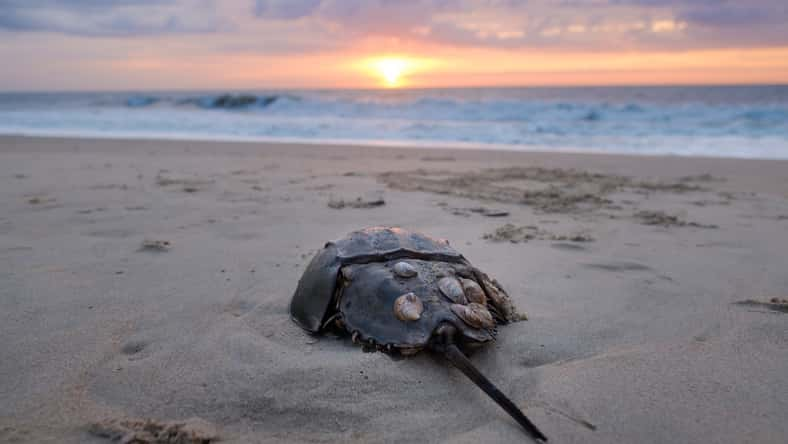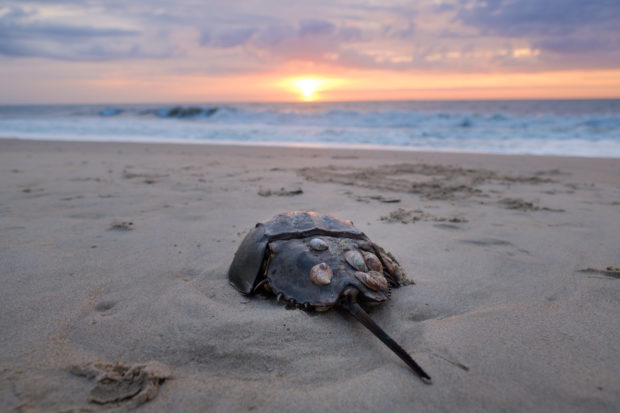The Blood Of Horseshoe Crabs Has Played A Critical Role In The Creation Of Vaccines For 30 Years Now, And This Is Why It’s So Special

When you think of vaccines and their life-saving impacts, horseshoe crabs probably do not come to mind. But, these crustaceans found along the Atlantic and Gulf coasts are actually critical to developing countless safe and effective vaccines.
Horseshoe crabs have been around for about four hundred and fifty million years– making these “living fossils,” as some call them, even older than the dinosaurs.
And aside from seeing them scurry down the shore at most beaches on the east coast, these crabs have also played a part in likely every vaccine you have ever received.
More specifically, horseshoe crabs’ blood– which is a striking neon blue color– has been instrumental in testing the safety of vaccines on humans.
The species has been used to detect endotoxins– which can cause severe health complications, including anaphylactic shock and death– in vaccines and other injectable medicines given to humans for over thirty years.
This is possible because horseshoe crab blood contains crucial immune cells that are extremely sensitive to toxic bacteria. And whenever the cells encounter such toxins, the crabs’ blood will immediately clot around it in order to protect the rest of its body.
Scientists first recognized this in the 1970s and developed a groundbreaking test known as Limulus Amebocyte Lysate (LAL), which essentially vets new vaccines for contamination before administering them to the public.
And most recently, during the COVID-19 pandemic, over one hundred different vaccine iterations were being tested around the world. During that time, many researchers heavily relied on horseshoe crab blood and the LAL test to determine the safety and efficacy of the inoculation efforts.
But, while the species has substantially helped mankind avoid and/or curb pandemics in the past, horseshoe crabs themselves are not reaping the same benefits.

Marc Kirby – stock.adobe.com – illustrative purpose only, not the actual person
Sign up for Chip Chick’s newsletter and get stories like this delivered to your inbox.
Instead, some die after they are bled for use in medical testing. Moreover, living alongside humans in North America and Asia has not been easy.
The prehistoric-looking crabs are often used as fishing bait or fall victim to the effects of pollution and rising tides.
Plus, numerous horseshoe crabs perish every year following mating season– when they become stranded upside down on shorelines.
And the species’ population loss can be devastating for ecosystems.
“The horseshoe crab is a critical link to coastal biodiversity. One of their ecological functions is to lay millions of eggs on beaches to feed shorebirds, fish, and other wildlife. Its large hard shell also serves as a microhabitat for many other species such as sponges, mud crabs, mussels, and snails,” explained the International Union for the Conservation of Nature (IUCN).
But, horseshoe crabs’ fate may not be entirely sealed– at least in terms of medical testing.
For years, no one was able to pinpoint a viable alternative to horseshoe crab blood for the LAL test.
But, during the late 1990s, researchers from the University of Singapore discovered that a synthetic alternative could be used in the LAL test by cloning a crab blood molecule. This genetically engineered protein is known as Recombinant Factor C (rFC).
Japan and China have already approved the use of rFC for medical testing. And Pfizer, the pharmaceutical company that developed one of the most widely used COVID-19 vaccines, also claimed they would not use horseshoe crab blood in their research.
However, synthetic ingredients such as rFC are still not widely utilized in some nations. For example, America still resorts to bleeding countless horseshoe crabs every year in pursuit of science.
Thankfully, though, regulators and manufacturers have issued protocol guidelines on how to lower the number of crabs killed during medical bleeding. Moreover, some pharmaceutical companies have created sustainability programs.
And finally, the IUCN did call for more stringent rules surrounding the preservation of horseshoe crabs and their role in medical research in 2019.
So, hopefully, it will not be long until the crustaceans’ blood is able to be swapped out for a less deadly alternative.
If true crime defines your free time, this is for you: join Chip Chick’s True Crime Tribe.
Everything You Ever Wanted To Know About The Strange History Of The Mysterious Ouija Board
More About:Human Interest